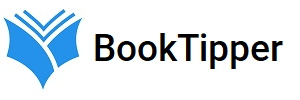Featured New Releases
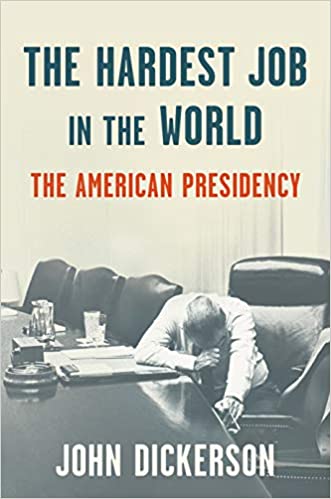
THE HARDEST JOB IN THE WORLD
by John Dickerson
From the veteran political journalist and 60 Minutes correspondent, a deep dive into the history, evolution, and current state of the American presidency—and how we can make the job less impossible and more productive.
“This is a great gift to our sense of theactual presidency, a primer on leadership.”—Ken Burns
Imagine you have just been elected president. You are now commander-in-chief, chief executive, chief diplomat, chief legislator, chief of party, chief voice of the people, first responder, chief priest, and world leader. You’re expected to fulfill your campaign promises, but you’re also expected to solve the urgent crises of the day. What’s on your to-do list? Where would you even start? What shocks aren’t you thinking about?
The American presidency is in trouble. It has become overburdened, misunderstood, almost impossible to do. “The problems in the job unfolded before Donald Trump was elected, and the challenges of governing today will confront his successors,” writes John Dickerson. After all, the founders never intended for our system of checks and balances to have one superior Chief Magistrate, with Congress demoted to “the little brother who can’t keep up.”
In this eye-opening book, John Dickerson writes about presidents in history such a Washington, Lincoln, FDR, and Eisenhower, and and in contemporary times, from LBJ and Reagan and Bush, Obama, and Trump, to show how a complex job has been done, and why we need to reevaluate how we view the presidency, how we choose our presidents, and what we expect from them once they are in office. Think of the presidential campaign as a job interview. Are we asking the right questions? Are we looking for good campaigners, or good presidents? Once a candidate gets the job, what can they do to thrive? Drawing on research and interviews with current and former White House staffers, Dickerson defines what the job of president actually entails, identifies the things that only the president can do, and analyzes how presidents in history have managed the burden. What qualities make for a good president? Who did it well? Why did Bill Clinton call the White House “the crown jewel in the American penal system”? The presidency is a job of surprises with high stakes, requiring vision, management skill, and an even temperament. Ultimately, in order to evaluate candidates properly for the job, we need to adjust our expectations, and be more realistic about the goals, the requirements, and the limitations of the office.

EXERCISE OF POWER
by Robert Gates
From the former secretary of defense and author of the acclaimed #1 best-selling memoir, Duty, a candid, sweeping examination of power in all its manifestations, and how it has been exercised, for good and bad, by American presidents in the post-Cold War world.
Since the end of the Cold War, the global perception of the United States has progressively morphed from dominant international leader to disorganized entity, seemingly unwilling to accept the mantle of leadership or unable to govern itself effectively. Robert Gates argues that this transformation is the result of the failure of political leaders to understand the complexity of American power, its expansiveness, and its limitations. He makes clear that the successful exercise of power is not limited to the use of military might or the ability to coerce or demand submission, but must encompass as well diplomacy, economics, strategic communications, development assistance, intelligence, technology, ideology, and cyber. By analyzing specific challenges faced by the American government in the post-Cold War period–Iran, Iraq, Afghanistan, North Korea, Syria, Libya, Russia, China, and others–Gates deconstructs the ways in which leaders have used the instruments of power available to them. With forthright judgments of the performance of past presidents and their senior-most advisers, firsthand knowledge, and insider stories, Gates argues that U.S. national security in the future will require learning, and abiding by, the lessons of the past, and re-creating those capabilities that the misuse of power has cost the nation.
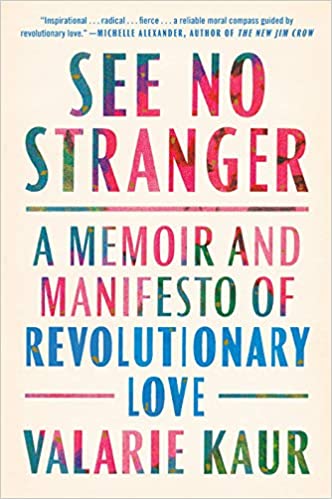
SEE NO STRANGER
by Valarie Kaur
How do we love in a time of rage? How do we fix a broken world while not breaking ourselves? Valarie Kaur—renowned Sikh activist, filmmaker, and civil rights lawyer—describes revolutionary love as the call of our time, a radical, joyful practice that extends in three directions: to others, to our opponents, and to ourselves. It enjoins us to see no stranger but instead look at others and say: You are part of me I do not yet know. Starting from that place of wonder, the world begins to change: It is a practice that can transform a relationship, a community, a culture, even a nation.
Kaur takes readers through her own riveting journey—as a brown girl growing up in California farmland finding her place in the world; as a young adult galvanized by the murders of Sikhs after 9/11; as a law student fighting injustices in American prisons and on Guantánamo Bay; as an activist working with communities recovering from xenophobic attacks; and as a woman trying to heal from her own experiences with police violence and sexual assault. Drawing from the wisdom of sages, scientists, and activists, Kaur reclaims love as an active, public, and revolutionary force that creates new possibilities for ourselves, our communities, and our world. See No Stranger helps us imagine new ways of being with each other—and with ourselves—so that together we can begin to build the world we want to see.

LOVE AND RAGE
by Lama Rod Owens
In the face of systemic racism and state-sanctioned violence, how can we metabolize our anger into a force for liberation?
White supremacy in the United States has long necessitated that Black rage be suppressed, repressed, or denied, often as a means of survival, a literal matter of life and death. In Love and Rage, Lama Rod Owens, coauthor of Radical Dharma, shows how this unmetabolized anger–and the grief, hurt, and transhistorical trauma beneath it–needs to be explored, respected, and fully embodied to heal from heartbreak and walk the path of liberation. This is not a book about bypassing anger to focus on happiness, or a road map for using spirituality to transform the nature of rage into something else. Instead, it is one that offers a potent vision of anger that acknowledges and honors its power as a vehicle for radical social change and enduring spiritual transformation.
Love and Rage weaves the inimitable wisdom and lived experience of Lama Rod Owens with Buddhist philosophy, practical meditation exercises, mindfulness, tantra, pranayama, ancestor practices, energy work, and classical yoga. The result is a book that serves as both a balm and a blueprint for those seeking justice who can feel overwhelmed with anger–and yet who refuse to relent. It is a necessary text for these times.

FEAR IS A CHOICE
by James Conner
From fighting for his life to pursuing a career in the NFL, ACC Player of the Year and star Pittsburgh Steelers running back James Conner has lived a story offering wisdom and advice for anyone who has faced adversity.
During his first two years at the University of Pittsburgh, running back James Conner became one of the Panthers’ biggest stars, breaking records and winning the adoration of fans. Then, in the first game of his junior year, disaster struck in the form of a torn MCL. During rehab, James’s health continued to inexplicably deteriorate until a chest X-ray and biopsy confirmed the unthinkable: a diagnosis of Hodgkin’s lymphoma. Suddenly, it wasn’t just the dream of an NFL career that was in jeopardy; it was James’s life. Yet when he shared the news of his diagnosis publicly, James rallied family, friends, and fans, with his message of hope and courage: “Fear is a choice. I choose not to fear cancer.” In just ten words, James defined his own journey on his own terms and refused to back down from one of the most dreaded diseases known to man.
Drawing strength from his faith in God and the support of his community and loved ones, James underwent treatment but continued to practice with his team despite the intense physical toll of chemotherapy. He was declared cancer-free within a year. Returning to the field in 2016, he finished his college career with a record-breaking 3,733 rushing yards and 56 touchdowns. Entering the NFL draft early, his success continued. Selected in the third round by the Pittsburgh Steelers, he quickly became one of the most beloved rookies in the league.
In Fear is a Choice, James candidly shares his experiences during his battle with cancer and beyond, encouraging readers and illustrating the spiritual truths and personal principles that got him through his darkest days. James Conner is an inspiration for everyone who wants to learn how to tackle life’s problems with dignity, faith, and determination.
Still Hot in Non-Fiction & Biography
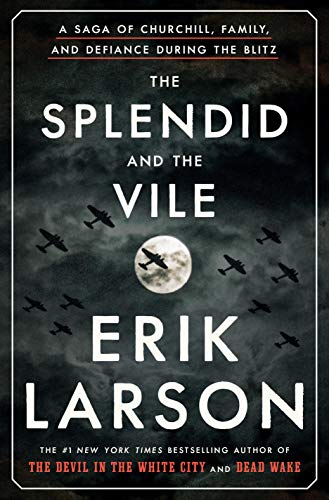
THE SPLENDID AND THE VILE
by Erik Larson
On Winston Churchill’s first day as prime minister, Adolf Hitler invaded Holland and Belgium. Poland and Czechoslovakia had already fallen, and the Dunkirk evacuation was just two weeks away. For the next twelve months, Hitler would wage a relentless bombing campaign, killing 45,000 Britons. It was up to Churchill to hold his country together and persuade President Franklin Roosevelt that Britain was a worthy ally—and willing to fight to the end.
In The Splendid and the Vile, Erik Larson shows, in cinematic detail, how Churchill taught the British people “the art of being fearless.” It is a story of political brinkmanship, but it’s also an intimate domestic drama, set against the backdrop of Churchill’s prime-ministerial country home, Chequers; his wartime retreat, Ditchley, where he and his entourage go when the moon is brightest and the bombing threat is highest; and of course 10 Downing Street in London. Drawing on diaries, original archival documents, and once-secret intelligence reports—some released only recently—Larson provides a new lens on London’s darkest year through the day-to-day experience of Churchill and his family: his wife, Clementine; their youngest daughter, Mary, who chafes against her parents’ wartime protectiveness; their son, Randolph, and his beautiful, unhappy wife, Pamela; Pamela’s illicit lover, a dashing American emissary; and the advisers in Churchill’s “Secret Circle,” to whom he turns in the hardest moments.
The Splendid and the Vile takes readers out of today’s political dysfunction and back to a time of true leadership, when, in the face of unrelenting horror, Churchill’s eloquence, courage, and perseverance bound a country, and a family, together.
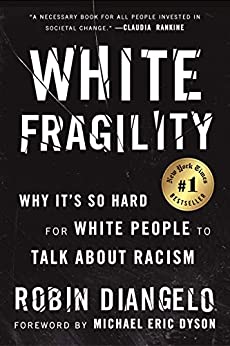
WHITE FRAGILITY
by Robin DiAngelo
The New York Times best-selling book exploring the counterproductive reactions white people have when their assumptions about race are challenged, and how these reactions maintain racial inequality.
In this “vital, necessary, and beautiful book” (Michael Eric Dyson), antiracist educator Robin DiAngelo deftly illuminates the phenomenon of white fragility and “allows us to understand racism as a practice not restricted to ‘bad people’ (Claudia Rankine). Referring to the defensive moves that white people make when challenged racially, white fragility is characterized by emotions such as anger, fear, and guilt, and by behaviors including argumentation and silence. These behaviors, in turn, function to reinstate white racial equilibrium and prevent any meaningful cross-racial dialogue. In this in-depth exploration, DiAngelo examines how white fragility develops, how it protects racial inequality, and what we can do to engage more constructively.
